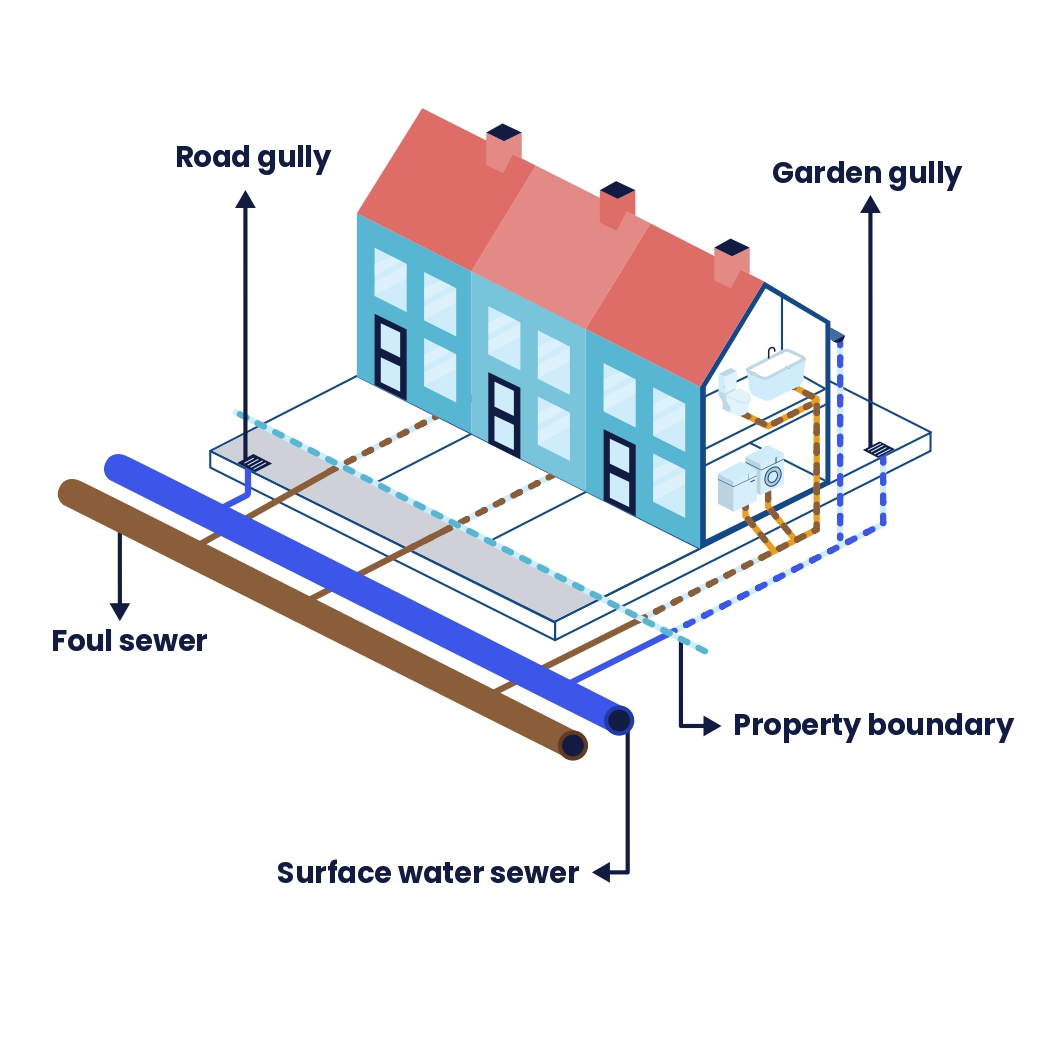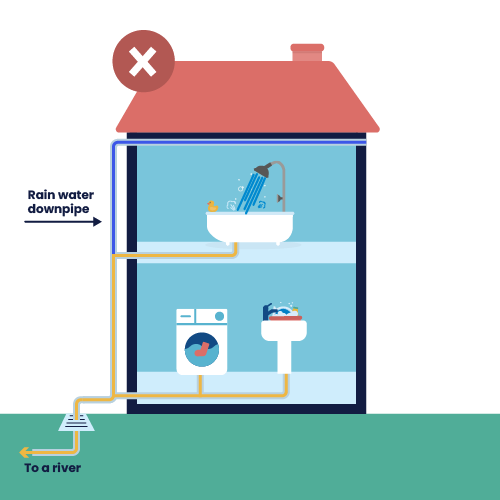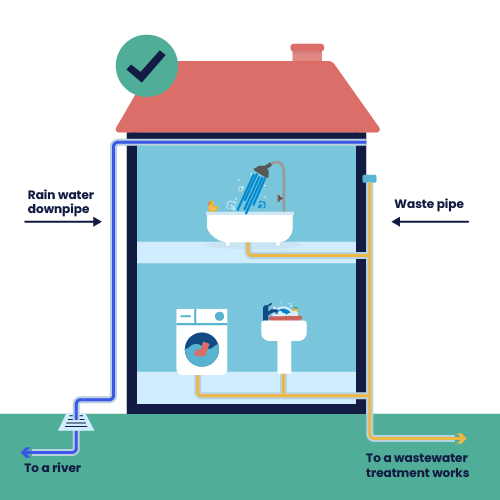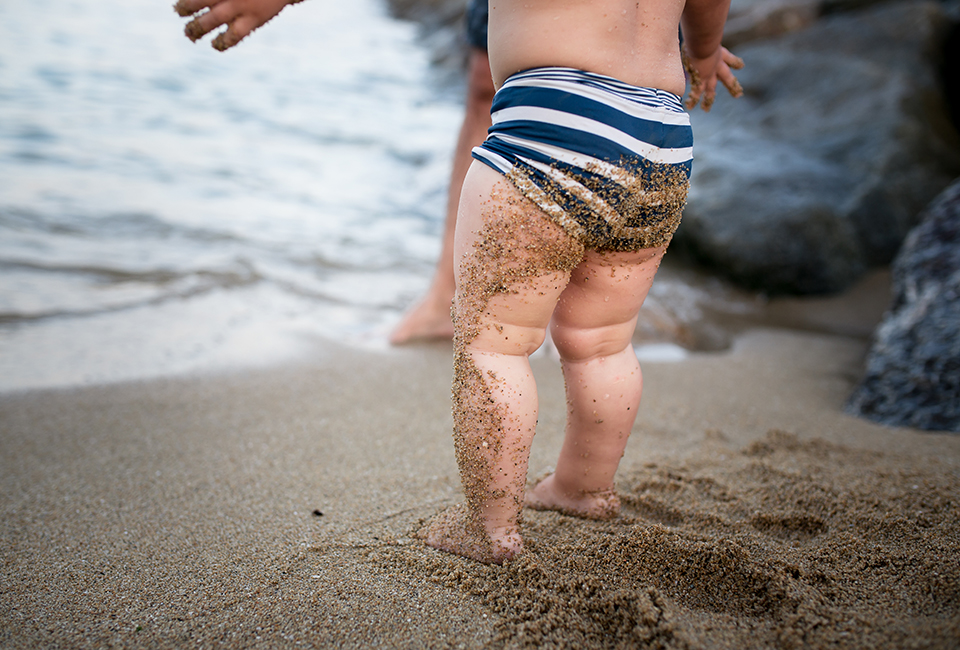What's a misconnection?
A misconnection is when a building's drains are incorrectly connected to the sewer network. This happens because of incorrect plumbing, installation of new appliances, and building, extending, or renovating houses.
Sometimes mistakes happen. A misconnection isn’t always done on purpose, but they can cause problems for the drainage systems and local watercourses.
Many houses have separate sewer systems for rainwater and wastewater.
Foul drain – this drain takes wastewater from bathrooms and household appliances, such as washing machines and dishwashers to a wastewater treatment works where it is treated before being safely released to rivers and streams.
Surface water drain – this drain carries rainwater runoff from roads, yards, gardens, and roof gutters directly to local rivers or streams.

Road gully
The highway authority is responsible for this
Foul sewer
Carries wastewater from toilets, taps, and appliances to a treatment works, where it's cleaned and processed
Surface water sewer
Takes rainwater from roofs and roads to rivers or the sea
Property boundary
The homeowner is responsible for the drains and pipes within the property boundary if the property was connected to the sewer before July 2011
Key
![]()
Your internal pipework
![]()
Your external pipework
![]()
Rainwater drain
![]()
Property boundary
What are the types of misconnections and why do they matter?
There are two main types of misconnection, and both can cause problems:
Foul-to-surface water misconnection
This is when wastewater from household appliances, like toilets and dishwashers, are plumbed into a surface water drain instead of a foul drain. That means dirty water goes straight into rivers and streams without being treated, - polluting the environment.
Here’s a video to explain a bit more:
Surface water-to-foul misconnection
This is when rainwater is wrongly connected to the foul drain, mixing with wastewater from bathrooms and other appliances. The more water in the wastewater network, the higher risk of properties flooding and our treatment works being overwhelmed. This rainwater should flow naturally back into the environment, not through the wastewater system.
Misconnection
This diagram shows how the washing machine, bathroom sink and shower have been misconnected to the surface water system.
This results in a pollution incident to the local watercourse.

Correct connection
This diagram shows the washing machine, bathroom sink and shower correctly connected to the waste pipe which goes to our wastewater treatment works.
The surface water system is separate and the rainwater flows into a watercourse without causing pollution.

What are the typical signs of a misconnection?
Spotting a misconnection can help reduce impacts to a watercourse in your local area. We may not always be able to see when sewers are overloaded with rainwater or where properties are connected into surface water pipes, so here’s a few common signs to keep an eye out for.
This includes:
- Outfalls that are causing discolouration in the watercourse
- Sewage related debris like toilet paper, wet wipes and faecal matter in the watercourse
- A noticeable sewage odour
- Bright white soap suds or foam in a river or stream
- Grey ‘feathery’ sewage fungus on a riverbed which indicates that this problem has been happening for quite some time.
How are we helping to reduce misconnections?
We’re finding misconnections from reports of issues in local waterways, or when we carry out other works. To help us we use data to understand changes in the flows in our sewer network.
When a contaminated watercourse has been found, the pollution can be traced back to the property where the waste pipes are misconnected using dye-testing and closed-circuit television (CCTV) surveys of the pipes.
Don’t worry! If we find a misconnection at your property, we’ll get in touch with more information to help you locate your misconnection and get it fixed.
The good news is, we’re working with local authorities and the Environment Agency to help fix misconnections. If you think there’s a problem in your area, please report the problem or call 0800 138 3484.
How to prevent misconnections from happening
You can play your part in protecting your local watercourses by making sure the connections in your property are plumbed into the correct drains.
Planning some home improvements? Avoid surprise costs and extra work by using a trusted, qualified trader – visit WaterSafe.org.uk to search for a qualified plumber in your area.
Not sure if your drains are connected properly? Simply visit ConnectRight or Water.org.uk to find out more.
Just so you know, as the homeowner, it’s your responsibility to cover the cost of fixing misconnections.
Who’s responsible for fixing misconnections?
The property owner is responsible for fixing misconnected pipes in the property. Including where the pipework meets the public sewer at the property boundary. We recommend you contact a qualified plumber to carry out the necessary work. If you’re renting your property; you should get in touch with the landlord to tell them about the issue.
Criminal offence
Most of the time, misconnections are fixed quickly and stop being a problem, however under section 109 Water Industry Act 1991, it’s a criminal offence to cause a drain or sewer to communicate with a public sewer in contravention of section 106.
Section 106 Water Industry Act 1991 states that, where separate public sewers are provided for foul water and for surface water, it is unlawful to discharge directly or indirectly:
- foul water into a sewer provided for surface water; and
- surface water into a sewer provided for foul water (except with Yorkshire Water’s consent).
It’s also unlawful to have drains or sewer made to communicate directly with a storm-water overflow sewer.
Where a misconnection is not resolved in a reasonable timeframe, the local authority or Environment Agency may take further action.

